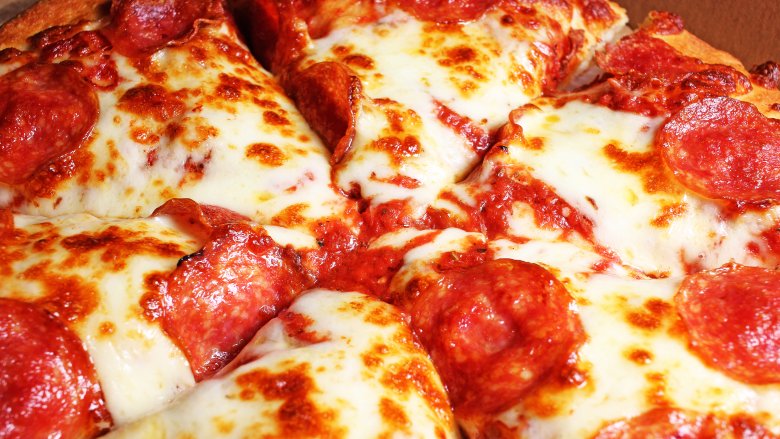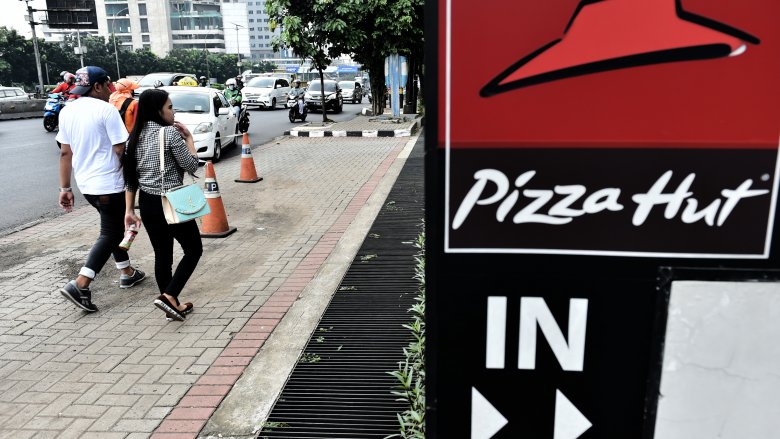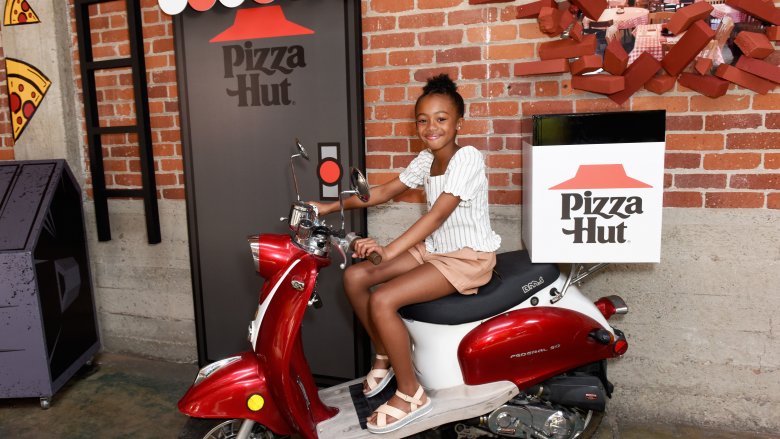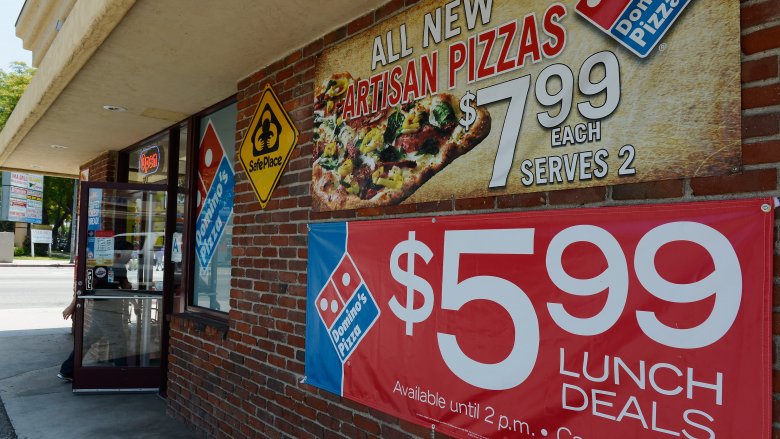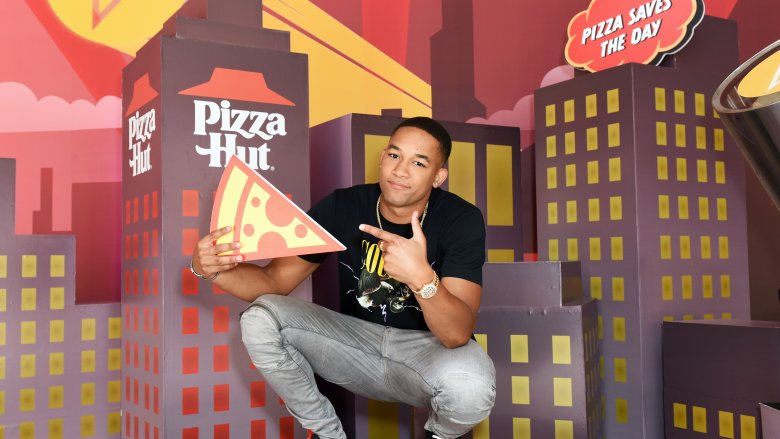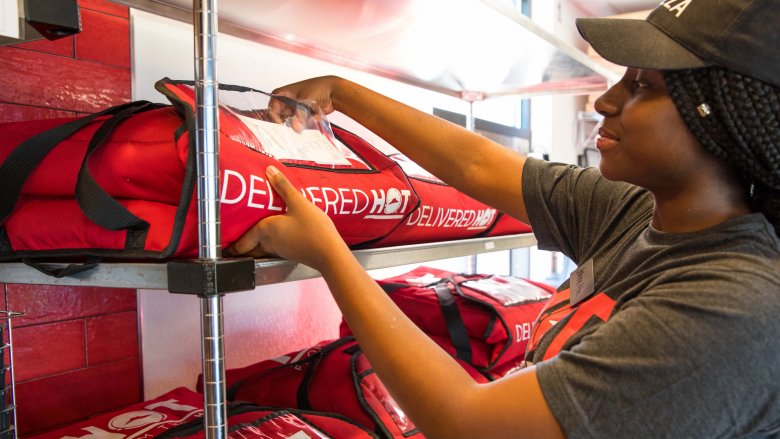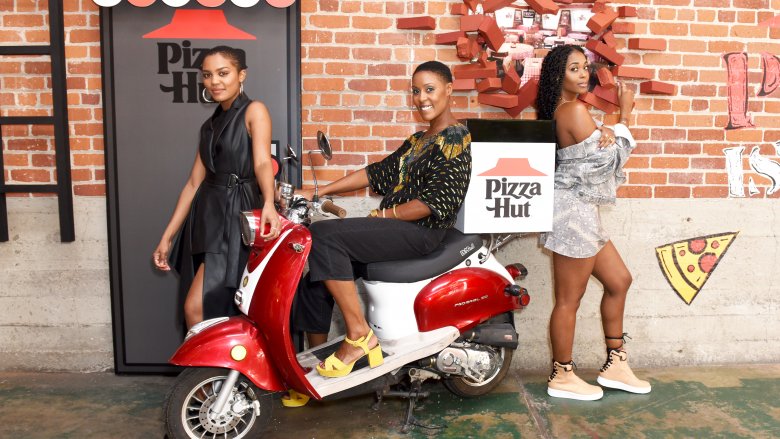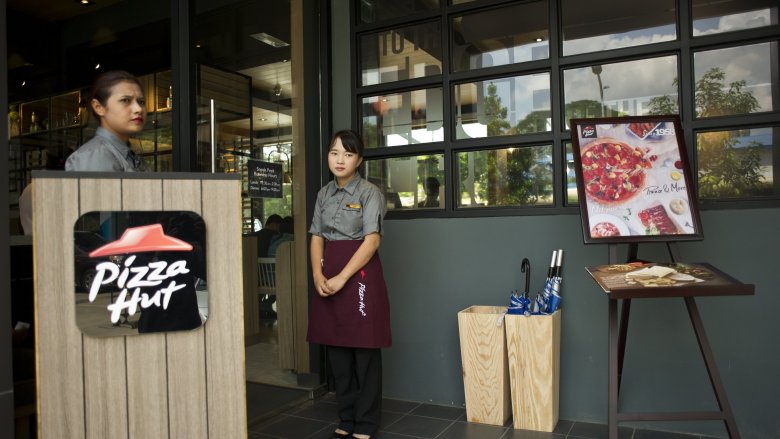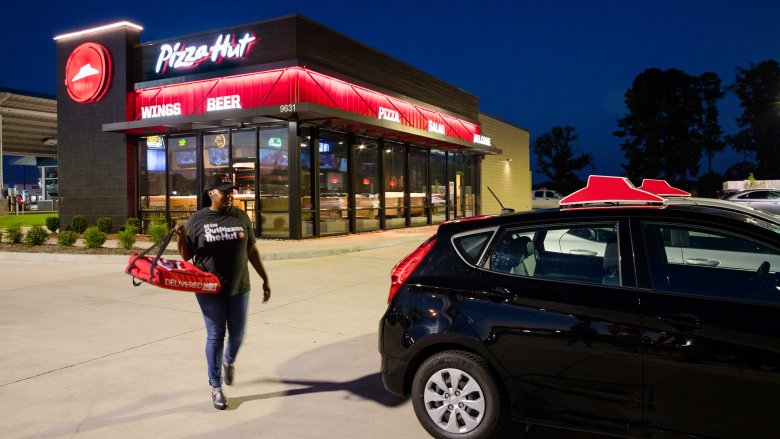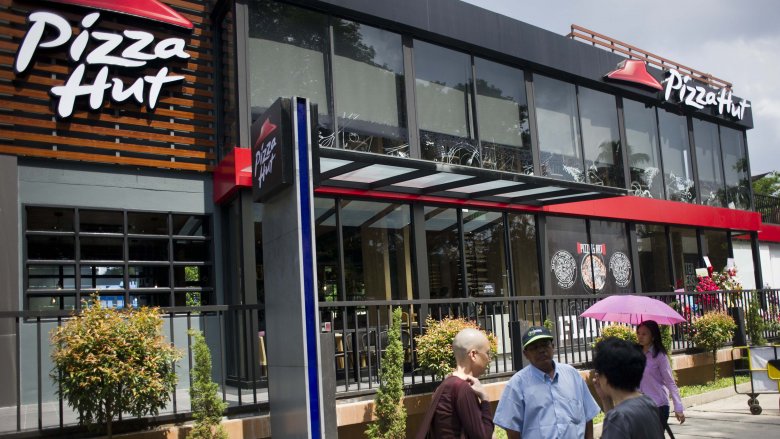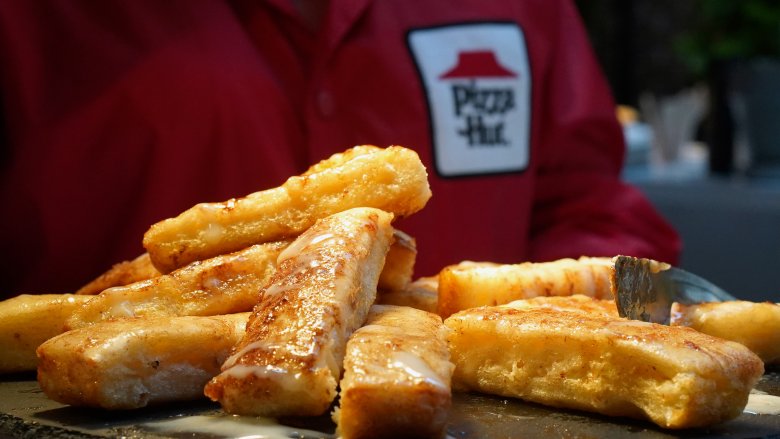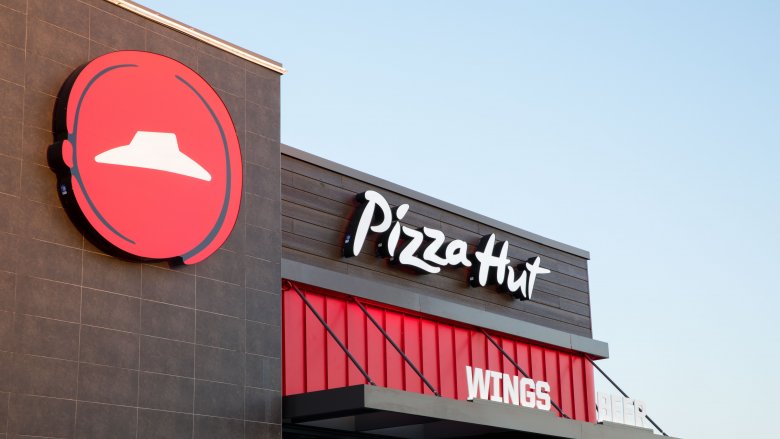The Real Reason Pizza Hut Is Disappearing Across The Country
There's a whole generation of readers out there who have some seriously fond memories of Pizza Hut. Thanks to their Book It! program, they gave countless kids their very first experiences going into a restaurant, ordering their pizza, and then "paying" for it themselves. That's a big deal when you're a kid, and it's no wonder it was such a success.
And that means there are a ton of people out there who felt a certain sort of nostalgic pang when Pizza Hut announced they were going to be closing around 500 stores, starting in 2019. According to president and CFO David W. Gibbs (via Nation's Restaurant News), they expect to see their store count decrease — a lot — before they're re-positioned to make a comeback. But, on the plus side, reopening stores is also a part of the plan... eventually.
So, what happened to this favorite of school kids everywhere? Times have changed, but Pizza Hut really didn't. That's at the heart of the problem, but like many things, it's more complicated than that. There's some stiff competition out there when it comes to pizza, so why is Pizza Hut losing ground?
Pizza Hut's customers don't want to dine-in
Remember taking your Book It! certificate in to Pizza Hut? What did you do? You sat down, you waited for your pizza, then you ate your pizza, right? And that's a huge problem in today's restaurant landscape.
According to Restaurant Business, only about 10 percent of Pizza Hut's sales come from dine-in customers. At the same time, about half their locations were paying a wait staff and supplying dine-in facilities. It doesn't take a business major to know that just doesn't add up.
When Pizza Hut CFO David Gibbs addressed the problem of earnings back in 2018, he had this to say: "The challenge Pizza Hut faces is that it has a large dine-in business. The drag dine-in is having on reported same-store sales masks the relative health of delivery and carryout. ... Dine-in is waning in relevance."
In other words, Pizza Hut needs to focus less on dine-in and more on what people want, which is to take their pizza with them. When the 500-odd closures were announced (via Nation's Restaurant News), Gibbs added that it wasn't the end for those locations... not entirely, at least. Most of the locations that are slated for closure are those geared toward a dine-in clientele, and the plan is to replace them with express locations better geared toward catering to more customers and their desire to be in and out the door with their pizza.
Pizza Hut is revamping their business model to express stores
When the closures stop and Pizza Hut stores start to reopen, they're going to look very different. Their Express store format is already out there, and if you're wondering what your neighborhood Pizza Hut is going to look like, think of a quick-serve counter and a shop like the one that's already at the Miami International Airport.
The Express format has already seen some success in international locations, and Pizza Hut Singapore describes it like this: "Pizza Hut Express is a fast service counter concept specially designed to serve the busy professionals, students and all who ... are looking for a filling meal while on the move."
Dozens have already opened across the UK as well, and Big Hospitality says owner/operators report huge successes with them. The menu is smaller than a traditional Pizza Hut and includes personal-sized pizzas, they fit in locations (like in stadiums and service stations) where a full-sized Pizza Hut wouldn't, and they're designed to be able to have an order out in between 90 and 120 seconds.
With the surging popularity of fast casual restaurants, it sounds like a logical move that's going to allow Pizza Hut to shift their branding and service model to be more of what people want — and in this case, the closures really do seem like a way of moving forward.
Pizza Hut hasn't kept up with rival discount programs
In 2018, CNN took a look at just how Domino's had risen to the top of the pile of national pizza chains, and they said they did it with a combination of creative marketing, tech innovations, and an overhaul to their menu and recipes. But their price point was also a big deal, and they said that since Domino's is more affordable than competitors — especially Pizza Hut — that had customers heading there.
Bloomberg has also said that's part of Pizza Hut's problem. Across the market you can find pizza places big and small offering all kinds of deals and discounts. Pizza Hut? Not so much. It's a delicate balance: Many budget-conscious families aren't just looking for great pizza, they're looking for a great deal. Pizza Hut needs to figure out how to offer discounts to get people in the door (or picking up the phone to call in a delivery order) while still giving them enough room to make a profit. It's tricky and so far, Domino's is doing it better.
Yum! CEO Greg Creed has said (via Restaurant Business) that it's something they're aware of, and it's been an ongoing challenge. Not only are they trying to find a way to get their menu to the right price point, but they're also having trouble getting all their franchisees on board with the program. He said: "We have to do a better job communicating better value."
Pizza Hut was lacking in message and identity
Let's try something here to illustrate a point. Every chain has a distinct identity, something you think of when you hear the mention of a name or see a sign as you're driving along. When you think of Burger King, you think of the Whopper and that creepy mascot, right? McDonald's? French fries and Ronald McDonald. Subway? Eat fresh. Little Caesars? Pizza, pizza! Starbucks? The Frappuchino. Pizza Hut? ...can you think of anything?
Exactly. According to Yum! CEO Greg Creed (via Restaurant Business), one of the things they're lacking is a strong brand identity. Any chain needs to cultivate an image, a reason for people to remember they're an option and to encourage them to stop by. But Creed says Pizza Hut's message "was not distinctive enough to attract new customers," and that's a huge problem.
They've known the problem as been there, but it still is. It's not enough for Pizza Hut to just be a pizza place any more, they need to define themselves more concretely. After all, if Pizza Hut doesn't know what it is, how are customers supposed to know they want to go there?
Delivery driver lawsuits have cost Pizza Hut millions
Pizza Hut might be shifting their dine-in image to one that's more focused on delivery and carryout, but in recent years, their delivery drivers have had them paying out millions. In 2016, Top Class Actions reported that they agreed to settle a lawsuit for $3.1 million. The suit was monumental; at the time, it resulted in the highest per-person payout of any delivery driver related settlement, and it all started because Florida drivers took them to court for being constantly underpaid.
Then, in 2017, Pizza Hut paid $9 million to settle a lawsuit brought after a 2009 accident where one of their delivery drivers hit and seriously injured a motorcyclist, who spent months in the hospital (via the Las Vegas Review-Journal).
The following year, almost 2,500 delivery drivers past and present were finally getting their payday when a Wisconsin franchisee agreed to a $2 million settlement. The lawsuit was brought by drivers who were employed by the owner of 72 Pizza Huts, and it was claimed they weren't reimbursed for things like gas and maintenance on their vehicles). And also in 2018, the AP reported a Wichita, Kansas man was suing after one of their delivery drivers hit and killed his mother and seriously injured his grandmother. Delivery might be the way of Pizza Hut's future, but only after a good long look at their policies and practices.
Pizza Hut underestimated millennials
In 2016, CNBC pointed out how important the millennial market was to the pizza industry. Between 2015 and 2016, their share of the pizza market rose from $38.5 billion to $45 billion, and that meant they were a huge part of the industry's revenue stream. At the time, that was split between the 70,000-odd pizzerias in the U.S., with the big four (Pizza Hut, Domino's, Papa John's, and Little Caesars) taking in around $23.5 billion in 2015. So, you'd think that Pizza Hut would spend a lot of time and effort focusing on catering the millennial market and offering things like high-quality ingredients, a lot of choices, and fast service. And — there's the important thing — getting that focus right.
But they haven't been able to compete with Domino's, who went right after the millennial market with things like an advertising campaign that made fun of their own pizza and promised to do better, a super user-friendly app, and a pizza tracker (via The Takeout).
Pizza Hut has lagged behind in the courtship, and even when they've reached out to the millennial market, it's been a miss. Deadspin poked fun at how they launched a few menu items with millennials in mind, and hoped their new cookie dessert and bacon-cheese stuffed crust pizza was going to be a hit. Their expletive-laden condemnation ended with one basic word that summed up Pizza Hut's attempts: "weak."
Pizza Hut is being overlooked by the student demographic
Everyone loves pizza, but who really, really loves pizza and eats of ton of it? Students. Unfortunately for Pizza Hut, they're not even on the radar when it comes to the student demographic.
According to MarketWatch, part of Pizza Hut's problem is that students are preferring to get their pizza from Papa John's and Domino's, and market analysts say their recent efforts to wade deeper into the technological world is only addressing part of the problem. Experts from GlobalData say it's not just about technology like order-placing apps, it's also about image and brand perception and price points (because no one gets excited about a deal on pizza like hungry college kids) — and they're just not appealing to the student demographic the way they should be if they want to become relevant.
Pizza Hut parent company Yum! Brands, Inc., is making strong headway with their other chains. Same-store sales at Taco Bell and KFC were on the rise, but Pizza Hut "still falls a bit short." The good news is that Pizza Hut knows there's a problem, and says they're willing to make the commitment to fix things — including making sure they appeal to new customer demographics.
Pizza Hut was behind in the digital world
If Domino's is the young, hip, tech-savvy pizza chain, then Pizza Hut is the grandmother. You love the old dear, but if she calls one more time because she can't figure out where the internet button went, you're going to go smash that computer for the good of everyone involved.
And that's not an exaggeration. While USA Today says Domino's has spent years playing with tech — even testing driverless delivery vehicles and perfecting their pizza tracker — Pizza Hut has been lagging behind in a big way. In 2014, The Washington Post took a look at why Domino's was giving Pizza Hut such a solid spanking, and even then they said they knew it had a lot to do with their behind-the-times approach to technology. They promised to catch up (and even surpass) the competition in 2015, but years later, it's just not happening.
Fast forward to 2018, and The Takeout still credited Domino's tech-savvy nature — and Pizza Hut's lack of tech — as a reason Pizza Hut is lagging behind. Unfortunately, developing new tech isn't something that happens overnight, and it's going to take them a long time to catch up with the rest of the playing field.
No one wanted a gourmet Pizza Hut
Pizza Hut hasn't been completely overlooking the millennial market, but when they tried overhauling their menu with the "Flavors of Now" campaign in 2014, it was a big swing... and an even bigger miss.
According to Business Insider, it was the biggest change in Pizza Hut menu history. It was done with the help of New York food truck operators, and the new flavors, ingredients, and crusts were developed with millennials in mind. But they weren't at all impressed with Ginger Boom Boom crusts and balsamic drizzles. PMQ reported that after the menu revamp, Pizza Hut saw a 3.5 percent drop in quarterly sales.
The Motley Fool suggests that the failed rebrand might have done some lasting damage, sending a mixed message and making customers unsure of just what Pizza Hut was trying to be and what patrons should expect when they got there. Are they a gourmet pizza place? A family pizza place? A place to call for takeout and delivery? While it still seems a little uncertain just what kind of Pizza Hut people want, a gourmet Pizza Hut definitely isn't it.
Pizza Hut forgot to keep old customers while they tried to attract new
When Pizza Hut gave themselves that major overhaul in 2014, they made more than one mistake. On one hand, there's nothing wrong with menu changes. Menus should be updated every so often, but here's the thing — they shouldn't be so different that they alienate a customer base that's already there.
According to Business Insider, the overhaul scared off some of those that were already heading to Pizza Hut, saying the menu overhaul was particularly alienating to long-time customers and families. Instead of seeing sales skyrocket, they suddenly found themselves needing to win back their loyal customer base. By 2015, The Drum was reporting that they were reevaluating their market strategy to focus on all parts of the market, not just a singular demographic.
Yum! Brands CEO explained it to investors like this: "Unfortunately, we haven't been as effective as we've liked with our marketing and need to balance its appeal to millennials with mainstream pizza customers. We intend to do this going forward..."
Pizza Hut failed at updating their image
Quick, picture the inside of a Pizza Hut. You're picturing those red-and-white table cloths, a Pac-Man table, and a few arcade machines, aren't you? That was the Pizza Hut of both the 1980s and 1990s, and it's entirely possible that your old mental picture of Pizza Hut is a problem that could be turned into a solution.
In 2018, Pizza Hut exec Artie Starrs said (via Inc.) it was a big problem they'd forgotten to tell customers they'd changed. They didn't advertise their delivery service, they didn't update their look, and they didn't climb to the top of the highest mountain around and shout they weren't your parents' Pizza Hut anymore, they were your Pizza Hut. Advertising had fallen short, they said, but it's entirely possible they're fixing this in one of the most creative ways possible: by capitalizing on that retro feel.
In 2019, Pizza Hut reverted back to some of the old imagery and logos they used in the marketing campaigns that ran from 1967 to 1999. A huge part of that is the red roof and the shape of their building. If you happen to drive past a place that was built as a Pizza Hut and then repurposed into something else, you still know it was once Pizza Hut, don't you? That's powerful stuff, and Salon says they're hoping to capitalize on nostalgia to get adults who once ate there as children back with their own children.
Will it work?
